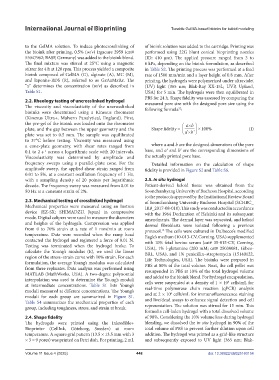Page 456 - v11i4
P. 456
International Journal of Bioprinting Tunable GelMA-based bioinks for keloid modeling
to the GelMA solution. To induce photocrosslinking of of bioink solution was added to the cartridge. Printing was
the bioink after printing, 0.5% (w/v) Irgacure 2959 (cat# performed using 22G blunt conical bioprinting nozzles
55047962; BASF, Germany) was added to the bioink blend. (ID: 410 μm). The applied pressure ranged from 3 to
The final mixture was stirred at 25°C using a magnetic 6 kPa, depending on the bioink formulation, as described
stirrer for 4 h at 120 rpm. This process yielded a composite in Table S2. The printing process was performed at a feed
bioink composed of GelMA (G), alginate (A), MC (M), rate of 1500 mm/min and a layer height of 0.8 mm. After
and laponite-RDS (R), referred to as GxAxMxRx. The printing, the hydrogels were polymerized under ultraviolet
“x” determines the concentration (w/v) as described in (UV) light (365 nm; Blak-Ray XX-15L; UVP, Upland,
Table S1. USA) for 5 min. The hydrogels were then equilibrated in
PBS for 24 h. Shape fidelity was assessed by comparing the
2.2. Rheology testing of uncrosslinked hydrogel measured pore size with the designed pore size using the
The viscosity and viscoelasticity of the uncrosslinked following formula :
22
bioinks were determined using a Kinexus rheometer
(Kinexus Ultra+, Malvern Panalytical, England). First,
the pre-gel of the bioink was loaded onto the rheometer ab
plate, and the gap between the upper geometry and the Shape fidelity = a’ b’ 100% (I)
plate was set to 0.5 mm. The sample was equilibrated
to 37°C before testing. Viscosity was measured using
a cone-plate geometry, with shear rates ranged from where a and b are the designed dimensions of the pore
0.1 to 2 s across a logarithmic scale with 20 intervals. base, and aʹ and bʹ are the corresponding dimensions of
−1
Viscoelasticity was determined by amplitude and the actually printed pore base.
frequency sweeps using a parallel-plate cone. For the Detailed information on the calculation of shape
amplitude sweep, the applied shear strain ranged from fidelity is provided in Figure S2 and Table S6.
0.01 to 5%, at a constant oscillation frequency of 1 Hz,
with a sampling density of 20 points per logarithmic 2.5. In situ hydrogel
decade. The frequency sweep was measured from 0.01 to Patient-derived keloid tissue was obtained from the
50 Hz at a constant strain of 2%. Soonchunhyang University of Bucheon Hospital, according
to the protocols approved by the Institutional Review Board
2.3. Mechanical testing of crosslinked hydrogel of Soonchunhang University Bucheon Hospital (SCHBC_
Mechanical properties were measured using an Instron IRB_2017-08-010). This study was conducted in accordance
device (EZ-SX; SHIMADZU, Japan) in compressive with the 1964 Declaration of Helsinki and its subsequent
mode. Digital calipers were used to measure the diameters amendments. The dermal layer was separated, and keloid
and heights of the hydrogels. Compression was applied dermal fibroblasts were isolated following a previous
from 0 to 70% strain at a rate of 1 mm/min at room protocol. The cells were cultured in Dulbecco’s modified
18
temperature. Data were recorded when the ramp head Eagle’s medium (10-013-CV, Corning, USA) supplemented
contacted the hydrogel and registered a force of 0.01 N. with 10% fetal bovine serum (cat# 35-015-CV, Corning,
Testing was terminated when the hydrogel broke. To USA), 1% l-glutamine (200 mM; cat# 25030081, Gibco-
calculate the Young’s modulus (E), we used the linear BRL, USA), and 1% penicillin–streptomycin (15140122,
region of the stress–strain curve with 10% strain. For each Life Technologies, USA). The bioinks were prepared in
formulation, the average Young’s modulus was calculated PBS at 80% of the total volume. Next, the cell pellet was
from three replicates. Data analysis was performed using resuspended in PBS at 10% of the total hydrogel volume
MATLAB (MathWorks, USA). A two-degree polynomial and added to the bioink blend. For hydrogel encapsulation,
interpolation was used to determine the Young’s moduli cells were suspended at a density of 1 × 10 cells/mL for
6
at intermediate concentrations. Table S1 lists Young’s real-time polymerase chain reaction (qPCR) analysis
moduli measured at different concentrations. The Young’s and at 2 × 10 cells/mL for immunofluorescence staining
6
moduli for each group are summarized in Figure S1. and live/dead assays to enhance signal detection and cell
Table S4 summarizes the mechanical properties of each
group, including toughness, stress, and strain at break. representation. The solution was stirred for 15 min. This
formed a cell-laden hydrogel with a total dissolved volume
2.4. Shape fidelity of 90%. Considering the 10% volume loss during hydrogel
The hydrogels were printed using the Inkredible+ blending, we dissolved the in situ hydrogel in 90% of the
Bioprinter (CellInk, Göteborg, Sweden) at room total volume of PBS to prevent further dilution upon cell
temperature. A square grid pattern (13.5 × 13.5 mm with 3 addition. The hydrogel was printed as a grid-like structure
× 3 = 9 pores) was printed on Petri dish. For printing, 2 mL and subsequently exposed to UV light (365 nm; Blak-
Volume 11 Issue 4 (2025) 448 doi: 10.36922/IJB025160154

